The Painted Word Read online
Page 2
The artist’s payoff in this ritual is obvious enough. He stands to gain precisely what Freud says are the goals of the artist: fame, money, and beautiful lovers. But what about le monde, the culturati, the social members of the act? What’s in it for them? Part of their reward is the ancient and semi-sacred status of Benefactor of the Arts. The arts have always been a doorway into Society, and in the largest cities today the arts—the museum boards, arts councils, fund drives, openings, parties, committee meetings—have completely replaced the churches in this respect. But there is more!
Today there is a peculiarly modern reward that the avantgarde artist can give his benefactor: namely, the feeling that he, like his mate the artist, is separate from and aloof from the bourgeoisie, the middle classes … the feeling that he may be from the middle class but he is no longer in it… the feeling that he is a fellow soldier, or at least an aide-de-camp or an honorary cong guerrilla in the vanguard march through the land of the philistines. This is a peculiarly modern need and a peculiarly modern kind of salvation (from the sin of Too Much Money) and something quite common among the well-to-do all over the West, in Rome and Milan as well as New York. That is why collecting contemporary art, the leading edge, the latest thing, warm and wet from the Loft, appeals specifically to those who feel most uneasy about their own commercial wealth … See? I’m not like them—those Jaycees, those United Fund chairmen, those Young Presidents, those mindless New York A.C. goyisheh hog-jowled stripe-tied goddamn-good-to-see-you-you-old-bastard-you oyster-bar trenchermen … Avant-garde art, more than any other, takes the Mammon and the Moloch out of money, puts Levi’s, turtlenecks, muttonchops, and other mantles and laurels of bohemian grace upon it.
That is why COLLECTORS today not only seek out the company of, but also want to hang out amidst, lollygag around with, and enter into the milieu of … the artists they patronize. They want to climb those vertiginous loft building stairs on Howard Street that go up five flights without a single turn or bend—straight up! like something out of a casebook dream—to wind up with their hearts ricocheting around in their rib cages with tachycardia from the exertion mainly but also from the anticipation that just beyond this door at the top … in this loft… lie the real goods … paintings, sculptures that are indisputably part of the new movement, the new école, the new wave … something unshrinkable, chipsy, pure cong, bourgeois-proof.
TWO
The Public Is Not Invited (And Never Has Been)
I’m still a virgin. (Where’s the champagne?)
NOW WE CAN BEGIN TO UNDERSTAND HOW IT HAPPENED THAT the Modernists, Braque & Bros., completed almost all their stylistic innovations before the First World War, and yet Modern Art seems to belong to the postwar period. It is simply because the Boho Dance took place before the war and the Consummation took place afterward. This is not what is so often described as the lag between “the artist’s discoveries” and “public acceptance.” Public? The public plays no part in the process whatsoever. The public is not invited (it gets a printed announcement later).
Le monde, the culturati, are no more a part of “the public,” the mob, the middle classes, than the artists are. If it were possible to make one of those marvelous sociometric diagrams that sociologists tried to perfect in the 1950s, in which they tried to trace on a map the daily routes of key people in a community—a blue line for Community Leader A here and a red one for Leader B and a green one for Leader C and a broken sienna one for Bureaucrat Y, and so on—and the lines started moving around and intersecting here and there like a hallucinated Sony solid-state panel—if it were possible to make such a diagram of the art world, we would see that it is made up of (in addition to the artists) about 750 culturati in Rome, 500 in Milan, 1,750 in Paris, 1,250 in London, 2,000 in Berlin, Munich, and Düsseldorf, 3,000 in New York, and perhaps 1,000 scattered about the rest of the known world. That is the art world, approximately 10,000 souls—a mere hamlet!—restricted to les beaux mondes of eight cities.
The notion that the public accepts or rejects anything in Modern Art, the notion that the public scorns, ignores, fails to comprehend, allows to wither, crushes the spirit of, or commits any other crime against Art or any individual artist is merely a romantic fiction, a bittersweet Trilby sentiment. The game is completed and the trophies distributed long before the public knows what has happened. The public that buys books in hardcover and paperback by the millions, the public that buys records by the billions and fills stadiums for concerts, the public that spends $100 million on a single movie—this public affects taste, theory, and artistic outlook in literature, music, and drama, even though courtly elites hang on somewhat desperately in each field. The same has never been true in art. The public whose glorious numbers are recorded in the annual reports of the museums, all those students and bus tours and moms and dads and random intellectuals … are merely tourists, autograph seekers, gawkers, parade watchers, so far as the game of Success in Art is concerned. The public is presented with a fait accompli and the aforementioned printed announcement, usually in the form of a story or a spread of color pictures in the back pages of Time. An announcement, as I say. Not even the most powerful organs of the press, including Time, Newsweek, and The New York Times, can discover a new artist or certify his worth and make it stick. They can only bring you the news, tell you which artists the beau hamlet, Cultureburg, has discovered and certified. They can only bring you the scores.
We can now also begin to see that Modern Art enjoyed all the glories of the Consummation stage after the First World War not because it was “finally understood” or “finally appreciated” but rather because a few fashionable people discovered their own uses for it. It was after the First World War that modern and modernistic came into the language as exciting adjectives (somewhat like now, as in the Now Generation, during the 1960s). By 1920, in le monde, to be fashionable was to be modern, and Modern Art and the new spirit of the avant-garde were perfectly suited for that vogue.
Picasso is a case in point. Picasso did not begin to become Picasso, in the art world or in the press, until he was pushing forty and painted the scenery for Diaghilev’s Russian ballet in London in 1918. Diaghilev & Co. were a tremendous succès de scandale in fashionable London. The wild dervishing of Nijinsky, the lurid costumes—it was all too deliciously modern for words. The Modernistic settings by Picasso, André Derain, and (later on) Matisse, were all part of the excitement, and le monde loved it. “Art,” in Osbert Lancaster’s phrase, “came once more to roost among the duchesses.”
Picasso, who had once lived in the legendary unlit attic and painted at night with a brush in one hand and a candlestick in the other—Picasso now stayed at the Savoy, had lots of clothes made on Bond Street and nearby, including a set of tails, went to all the best parties (and parties were never better), was set up with highly publicized shows of his paintings, and became a social lion—which he remained, Tales of the Aging Recluse notwithstanding, until he was in his seventies.
Pablo Picasso.
Back in Paris, the new Picasso turned up at the theater with his kid gloves, canes, tall hats, capes, and dinner clothes, and the linings gave you a little silk flash every time he wheeled about in the lobby to chat with one of his hellish new friends … Our old pal Braque shook his head sadly … At least Derain had had the decency to confine himself to a blue serge suit when he was being lionized in London, and he had stuck to the company of local bohos in his off hours … But Picasso—Braque was like that incorruptible member of the Cénacle of the rue des Quatre Vents, Daniel D’Arthez, watching the decay of Lucien Chardon in Balzac’s Lost Illusions. With a sigh Braque waited for his old comrade Pablo’s imminent collapse as a painter and a human being … But the damnedest thing happened instead! Picasso just kept ascending, to El Dorado, to tremendous wealth but to much more than that, to the sainted status of Picasso, to the point where by 1950 he was known at every level of opinion, from Art News to the Daily News, as the painter of the twentieth century. As for Derain a
nd his blue serge suit and Braque and his scruples—the two old boys, both very nearly the same age as Picasso, i.e., about seventy, were remembered in 1950 chiefly as part of the pit crew during Picasso’s monumental victory.*
Not to beg the question of differences in talent—but here we have the classic demonstration of the artist who knows how to double-track his way from the Boho Dance to the Consummation as opposed to the artist who gets stuck forever in the Boho Dance. This is an ever-present hazard of the art mating ritual. Truly successful double-tracking requires the artist to be a sincere and committed performer in both roles. Many artists become so dedicated to bohemian values, internalize their antibourgeois feelings so profoundly, that they are unable to cut loose, let go, with that cathartic shriek—pain! ecstasy! paff paff paff paff paff paff—and submit gracefully to good fortune; the sort of artist, and his name is Legion, who always comes to the black-tie openings at the Museum of Modern Art wearing a dinner jacket and paint-spattered Levi’s … I’m still a virgin! (Where’s the champagne?)
* History, kind history, has improved Braque’s status considerably since his death in 1963.
THREE
Le Tout New York on a Cubist Horse
“Hitch your wagon to a star.” —Ralph Waldo Emerson
SO MODERN ART ENJOYED A TREMENDOUS SOCIAL BOOM IN Europe in the 1920s. And what about the United States? A painter, Marsden Hartley, wrote in 1921 that “art in America is like a patent medicine or a vacuum cleaner. It can hope for no success until ninety million people know what it is.” Bitter stuff! In fact, however, he couldn’t have gotten it more precisely wrong. Modern Art was a success in the United States in no time—as soon as a very few people knew what it was, the 400, as it were, as opposed to the 90 million.
These were New Yorkers of wealth and fashion, such as the Rockefellers and Goodyears, who saw their counterparts in London enjoying the chic and excitement of Picasso, Derain, Matisse, and the rest of Le Moderne and who wanted to import it for themselves. This they did. Modern Art arrived in the United States in the 1920s not like a rebel commando force but like Standard Oil. By 1929 it had been established, institutionalized, in the most overwhelming way: in the form of the Museum of Modern Art. This cathedral of Culture was not exactly the brain child of visionary bohemians. It was founded in John D. Rockefeller, Jr.’s living room, to be exact, with Goodyears, Blisses, and Crowninshields in attendance.
Against such a vogue in le monde, conservative critics in New York were helpless. Their very base no longer existed. The doyen of the breed, Royal Cortissoz, made a mighty effort, however. Writing in 1923, at the time of a national debate over immigration (which led to the Immigration Act of 1924), he compared the alien invasion of European modernism to the subversive alien hordes coming in by boat. “Ellis Island art,” he called it, no doubt figuring he had come up with a devastating label. Well!—as one can imagine!—how everybody sniggered at poor Mr. Cortissoz over that!
By the mid-1930s, Modern Art was already so chic that corporations held it aloft like a flag to show that they were both up-to-date and enlightened, a force in Culture as well as commerce. The Dole Pineapple Company sent Georgia O’Keeffe and Isamu Noguchi to Hawaii to record their impressions, and the Container Corporation of America was commissioning abstract work by Fernand Léger, Henry Moore, and others. This led to the Container Corporation’s long-running advertising campaign, the Great Ideas of Western Man series, in which it would run a Great Idea by a noted savant at the top of the page, one of them being “‘Hitch your wagon to a star’—Ralph Waldo Emerson.” Underneath would be a picture of a Cubist horse strangling on a banana.
Naturally the chic of Le Moderne put a heavy burden on theory. Each new movement, each new ism in Modern Art was a declaration by the artists that they had a new way of seeing which the rest of the world (read: the bourgeoisie) couldn’t comprehend. “We understand!” said the culturati, thereby separating themselves also from the herd. But what inna namea Christ were the artists seeing? This was where theory came in. A hundred years before, Art Theory had merely been something that enriched one’s conversation in matters of Culture. Now it was an absolute necessity. It was no longer background music. It was an essential hormone in the mating ritual. All we ask for is a few lines of explanation! You say Meret Oppenheim’s Fur-Covered Cup, Saucer and Spoon (the pièce de résistance of the Museum of Modern Art’s Surrealism show in December 1936) is an example of the Surrealist principle of displacement? You say the texture of one material—fur—has been imposed upon the forms of others—china and tableware—in order to split the oral, the tactile, and the visual into three critically injured but for the first time fiercely independent parties in the subconscious? Fine. To get the word was to understand. The Dadaists professed to be furious over this obscene embrace by the very people they had been attacking. “Any work of art that can be understood is the product of a journalist,” said Tristan Tzara’s Dada manifesto. “So what?” came the reply. (“You dismal little Rumanian.”) Even an explanation of why one couldn’t accept something, including Dada, was explanation enough to accept it.
Yet Theory did not come fully into its own, triumphant, transcendent, more important than painting and sculpture themselves, until after the Second World War. Theory, this first-class coach on the Freight Train of History (to use a phrase from the period), was held back by a little matter that seldom finds its way into the art histories today, as if what the Freudians call “the amnesia of childhood” were at work. For more than ten years, from about 1930 to 1941, the artists themselves, in Europe and America, suspended the Modern movement… for the duration, as it were … They called it off! They suddenly returned to “literary” realism of the most obvious sort, a genre known as Social Realism.
Left politics did that for them. Left politicians said, in effect: You artists claim to be dedicated to an antibourgeois life. Well, the hour has now come to stop merely posing and to take action, to turn your art into a weapon. Translation: propaganda paintings. The influence of Left politics was so strong within the art world during the 1930s that Social Realism became not a style of the period but the style of the period. Even the most dedicated Modernists were intimidated. Years later Barnett Newman wrote that the “shouting dogmatists, Marxist, Leninist, Stalinist, and Trotskyite” created “an intellectual prison that locked one in tight.” I detect considerable amnesia today on that point. All best forgotten! Artists whose names exist as little more than footnotes today—William Gropper, Ben Shahn, Jack Levine—were giants as long as the martial music of the mimeograph machines rolled on in a thousand Protest Committee rooms. For any prominent critic of the time to have written off Ben Shahn as a commercial illustrator, as Barbara Rose did recently, would have touched off a brawl. Today no one cares, for Social Realism evaporated with the political atmosphere that generated it. By 1946 the scene had cleared for the art of our day—an art more truly Literary than anything ever roared against in the wildest angers of the Fauvists and Cubists.
FOUR
Greenberg, Rosenberg & Flat
When Flat was God. Using the impastometer
NONE OF THE ABSTRACT EXPRESSIONIST PAINTINGS THAT REMAIN from the palmy days of 1946 to 1960—and precious few are still hanging except in museums and the guest bedrooms of Long Island beachhouses, back there with the iron bedstead whose joints don’t gee, the Russel Wright water pitcher left over from the set of dishes the newlyweds bought for their first apartment after the war, and an Emerson radio with tubes and a shortwave band … none of the paintings, as I say, not even Jackson Pollock’s and Willem de Kooning’s, makes quite as perfect a memorial to that brave and confident little epoch as the Theories. As for the paintings—de gustibus non disputandum est. But the theories, I insist, were beautiful.
Theories? They were more than theories, they were mental constructs. No, more than that even … veritable edifices behind the eyeballs they were … castles in the cortex … mezuzahs on the pyramids of Betz … crystalline … co
mparable in their bizarre refinements to medieval Scholasticism.
We can understand the spellbinding effect these theories had, however, only by keeping in mind what we have noted so far: (1) the art world is a small town; (2) part of the small town, le monde, always looks to the other, bohemia, for the new wave and is primed to believe in it; (3) bohemia is made up of cénacles, schools, coteries, circles, cliques. Consequently, should one cénacle come to dominate bohemia, its views might very well dominate the entire small town (a.k.a. “the art world”), all the way from the Chambers Street station to Eighty-ninth and Fifth.
And that is precisely what happened in New York after the Second World War in the era of Abstract Expressionism, when New York replaced Paris (as one was so often reminded) as the county seat of Modernism.
During the Dark Ages—i.e., the 1930s interlude of Social Realism—small cénacles of Modernists kept the faith alive down in bohemia, down below Fourteenth Street. They were like a real underground, for a change—in hiding this time not from that rather metaphysical menace, the bourgeoisie, but from their own comrade bohemian drillmasters, the aforementioned “shouting dogmatists” of the Left. Even Franz Kline, the abstract painter’s abstract painter, was dutifully cranking out paintings of unemployed Negroes, crippled war veterans, and the ubiquitous workers with the open blue work shirts and necks wider than their heads. But there were those who kept Modernism alive …

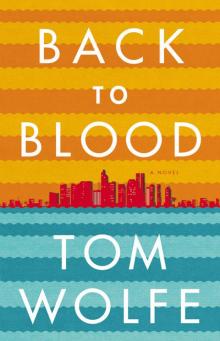 Back to Blood
Back to Blood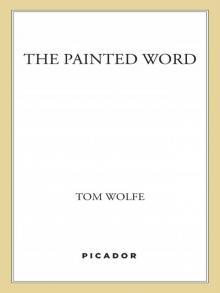 The Painted Word
The Painted Word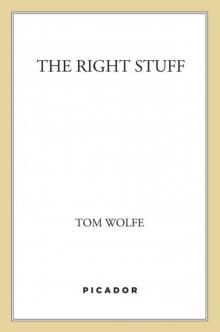 The Right Stuff
The Right Stuff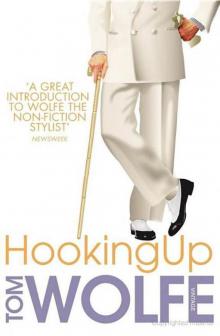 Hooking Up
Hooking Up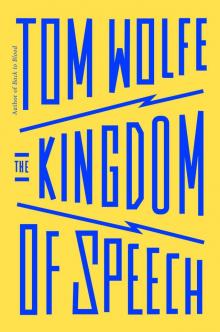 The Kingdom of Speech
The Kingdom of Speech The Bonfire of the Vanities
The Bonfire of the Vanities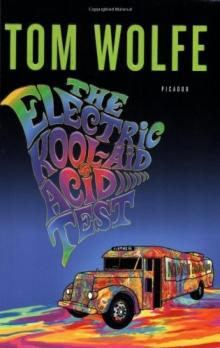 The Electric Kool-Aid Acid Test
The Electric Kool-Aid Acid Test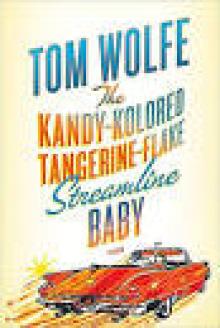 The Kandy-Kolored Tangerine-Flake Streamline Baby
The Kandy-Kolored Tangerine-Flake Streamline Baby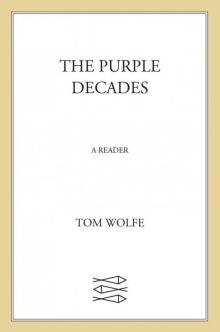 The Purple Decades - a Reader
The Purple Decades - a Reader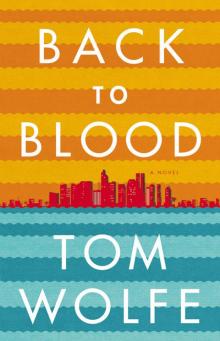 Back to Blood: A Novel
Back to Blood: A Novel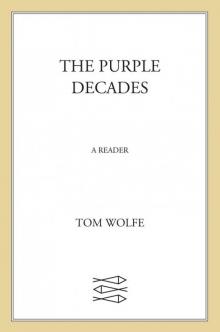 The Purple Decades
The Purple Decades